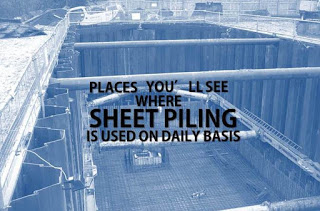It helps us to get to work, it protects our homes, and it even gives us a secure place to park, amongst many other uses.
So, with that in mind, we’re going to take a look at three places you’ll see sheet piling used on a daily basis.
 |
| 3 Places You’ll See Sheet Piling Used On A Daily Basis |
What is sheet piling?
Sheet piling is a method of construction used to retain large bodies of material behind a wall, whether it’s soil or water.
Large sheet panels made of wood, steel or plastic are driven into the ground with interlocking edges to create a strong, durable barrier. The interlocking edges create a rigid structure that’s used to protect structures from heavy materials exerting force on them, preventing them from collapsing.
These sheet pile walls can be erected as either a permanent structure or a temporary support during building excavations and are driven into the ground using vibratory or hydraulic hammers.
This post by Designing Buildings has some more information on the method of sheet piling.
Underground structures
Although many of us won’t have given much thought to how our underground structures are built, when you do stop and think, it can be quite an impressive feat!
If you were to just dig a hole and start laying concrete, the soil would constantly fall into the building site and get in the way of construction, so that’s where sheet piling comes in. The piles are driven into the ground and locked together, which holds back the large amounts of soil surrounding the structure, whilst also supporting the existing structure above.
Like Us on Facebook!
As result, sheet piling is used in the construction of residential basements as well as underground car parks and garages, pumping stations, and storage tanks.
Subscribe Us on YouTube!
For a better understanding of how it works, check out these case studies from Sheet Piling UK.
Flood defences
However, sheet piling isn’t just used to retain soil and it can also be used to hold back large bodies of water.
As a result, you’ll often see sheet piling off shores around the UK, being used to create dock walls, cofferdams, jetties, slipways and mooring dolphins. It’s main use, though, is in the creation of seawalls and flood defences.
These sheet piling structures play a huge part in not only protecting marinas and docks from flooding but also the homes of many coastal communities around the country, with seawalls helping to minimise the effects of any tidal floods.
In these instances, plastic is usually used in the piles as these won’t erode or rust in saltwater in the same way as steel.
This publication offers more information on the use of sheet piling in coastal structures.
Transport links
Finally, you’re likely to come across sheet piling whenever you’re travelling in your car or on the train.
In order to build railway tunnels, cut through hillsides to lay tracks or roads, or just to stop the vibrations of trains or lorries from causing a landslide, sheet piling will be used to retain and redistribute the large amounts of soil surrounding the structures.
As a result, this makes both travel and construction much safer!



















